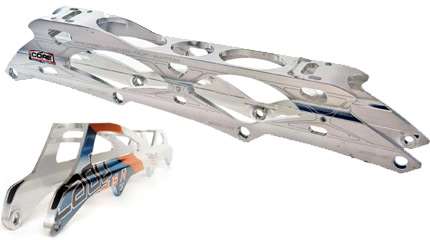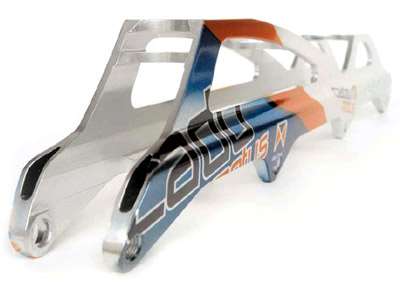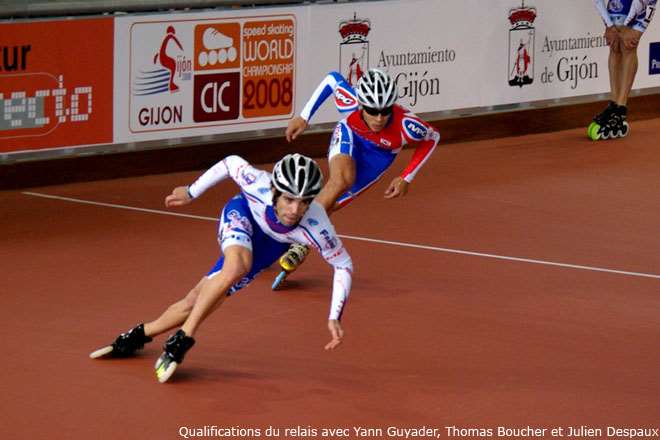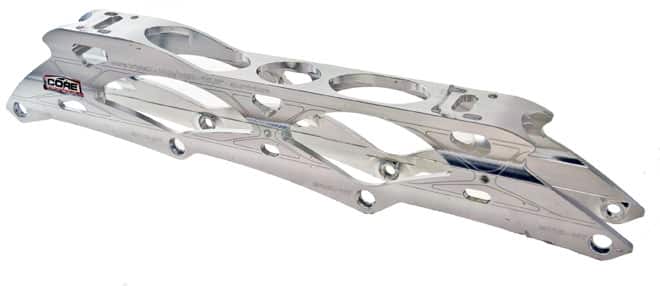How to choose your speed frames (Yann Guyader)
Par alfathor |
Publié le 23 November 2008 |
Mis à jour le 3 November 2020 |
Catégories :
All
Speed-skating
All
Speed-skating
| Sous-catégories :
how to choose your roller-skates and inline skates
how to choose your roller-skates and inline skates
| 29568
| Tags :
speed
Yann
your
How
choose
frames
OLS publishes the first article of a series written by Yann Guyader: with the multiplication and the evolution of the wheel diameters the last couple of years, it has become really hard to choose a frame adapted to your needs. Here are some useful tips from Yann…

A Cornelian choice?
 Since the 84mm wheels in 2004 we have witnessed three new changes as for wheel diameter. Because the wheels change, then the frames have to change too… These changes being more and more frequent, how to be sure that your choice is pertinent when you buy frames?
Since the 84mm wheels in 2004 we have witnessed three new changes as for wheel diameter. Because the wheels change, then the frames have to change too… These changes being more and more frequent, how to be sure that your choice is pertinent when you buy frames?
Let’s take into account several parameters:
- The most important is the choice of the wheel diameter compatible with the frame.
- The second is about its length, as there are different frame lengths for the same wheel diameter.
- And last but not least you’ve got to think about its design: flexible, stiff or polyvalent.
The wheel size
When you buy a frame, the first thing to check is the maximum wheel size. Your choice must be in accordance to your skating practice.
For Leisure skating or Beginner It is recommended to buy a 12’’ frame max, with 90mm wheels, which will be the best compromise between skating comfort and ease of movement with a polyvalent wheel size.
For Sports skates or Skaters occasionally taking part in races
Opt for 12’’8 frames with 100mm wheels.
For skaters often taking part in races, 110mm frames are the only alternative if you want to have a set-up enabling you to be competitive. But in this range of products, where the offer is excessive, it’s often tricky to know which frame to buy. It also can become a nightmare when no one inthere is able to give you the proper advice.
The keys to good choices
When you choose your 110mm frame, you’ve got to take your morphotype into account: tall with powerful muscles or small and frail. Your type of practice must also be taken into consideration: track or road, as well as your technical level…Here are the different sizes and types of frames adapted to speed-skating according to these precise criteria:
3×110-1×100 mmm
This type of frame, shorter and lower than a 4x110mm is ideal for people favoring reactivity and easy handling. It is also good for track skating as it makes the turns easier to handle, and the fact that it is lower is also a real advantage. However, this frame is not just limited to track speed skating. This year we had the opportunity to see its success amongst the skaters of the WIC. Lots of favorites even used it for marathons, including then winners of the last 5 editions: Massimiliano Presti and Yann Guyader; other renowned skaters had it too: Luca Saggiorato, Francesco Zangarini, Matteo Amabili but also Kalon Dobbin…This frame offers you an excellent skating comfort even when your physical condition is getting poorer. Moreover this frame is the best alternative for girls whatever the practice ground, track, road or road circuit.
4×110 mm
It’s the ultimate weapon for pure performance: its length gives you the best support as possible and enables you to reach high maximum speed without being unbalanced. It is thus very appreciated for fast races like Berlin.Let’s not forget that using this frame has some constraints: you’ve got to have an impeccable technique, or you’ll get caught out. Indeed when you start struggling physically, this kind of frame won’t do you any favor and your skating technique will tend to deteriorate.This frame is also reserved for tall hefty skaters for whom the frames won’t look like skis at their feet.Thus these frames are mainly for hefty people, skating principally on roads, as well as for technically skilled people who, despite a smaller built in some cases, will be able to handle them.
Stiffness of the frame
 After having checked the various sizes according to the various practices, you still have to decide whether you’d rather get a flexible or a stiff frame.
After having checked the various sizes according to the various practices, you still have to decide whether you’d rather get a flexible or a stiff frame.
Flexible or polyvalent frames
They will suit better track practice as they will optimize the turns and reinforce the mechanical support of the wheels during the push.Moreover this kind of frame enables easy and natural edging and better smoothness in pushes. They will be perfect for smaller skaters and for girls as its flexibility offers a wide range of use.
Stiff frames
They are the ones which transfer the push best and which are the most efficient. Nevertheless this kind of frame isn’t suitable for everybody: they can cause shin problems and difficult edging, and its use on track or road circuit won’t be optimum.These frames are recommended for powerful skaters, for road use principally or for speed skating like 200m sprints.

Links
“Choosing the right speed frames” by Christophe Audoire
Choice and set-up of speed skating boots
Fusion of technique and equipment
Translated by Close Yr E’s
Photos : Alfathor, Michel Terrien, all rights reserved
Auteur
Alexandre Chartier
''alfathor''
Alexandre est le fondateur et webmaster de rollerenligne.com depuis 2003. C'est un passionné de roller en général, tant en patin traditionnel qu'en roller en ligne. Il aime le patinage à roulettes sous tous ses aspects : histoire, économie, sociologie, évolution technologique... Aspirine et/ou café recommandés si vous abordez un de ces sujets !
